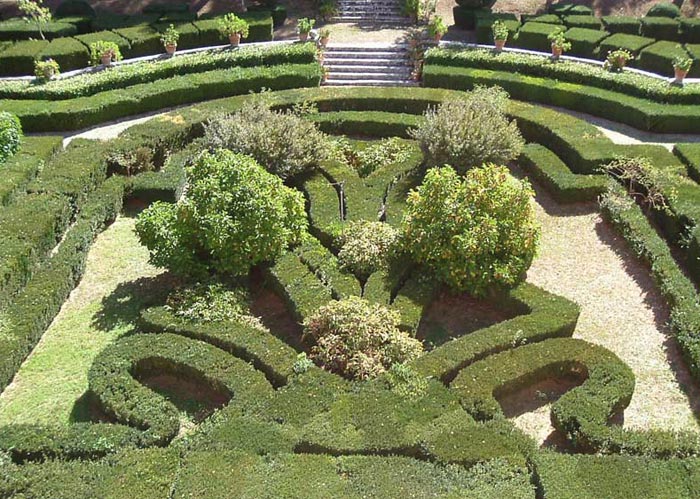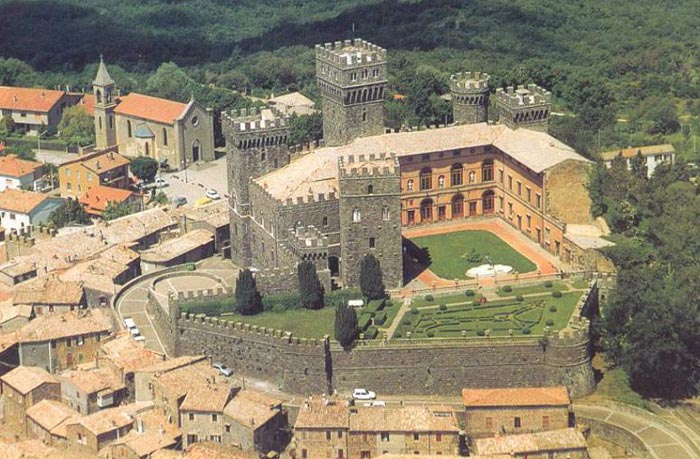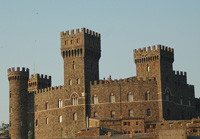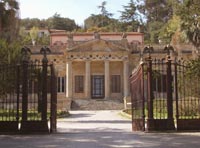 |
| Villa Cahen |
Villa Cahen The Villalba park is located in the Selva di Meana Parka. Part of the Mountain Community of Mount Peglia, the Selva di Meana stretches for 2,500 hectares. The vegetation is rich and includes, as well as woods and Mediterranean bush, several species of wild orchids. The Villalba park is located here. The hidden jewel in the center of the Park is the splendid Villa Cahen. In the marvellous gardens you can find various and rare arboreal and herbaceous species. |
||
 |
||
Castello di Torre Alfina
|
||
| Torre Alfina is a medieval picturesque village in the Acquapendente community. Torre Alfina is built around a castle that once belonged to the Monaldeschi and Bourbon del Monte families until it was purchased by Edoardo Cahen in 1880. The central tower (Cassero) was built by the Lombard king Desiderius. Edoardo Cahen was a Jewish banker who provided funds for the struggle to achieve a united Italy. He was given the title Marquis of Torre Alfina by King Umberto I in 1885. With the expansion of the village, the original fortress was fortified with a second ring of walls made of bastions, walls of houses and many gateways. Two of these gates disappeared with the renovation works of Marquis Cahen, while Porta Vecchia is still visible. The palace was built near the tower; and was the home to the successive Lords. The Monaldeschi Palace was renovated by Edward Cahen. Various parts of the village were involved and completely transformed, such as the area that faces the entrance ramp to the castle or the one overlooking Piazza Sant'Angelo, which is occupied by a roof garden and by the entrance staircase. This colossal work, which carried on until the end of the 1920’s, was assigned to the architect Giuseppe Partini from Siena. Edward Cahen never managed to see the castle finished but he wanted to be buried, in a mausoleum built in the same neo-Gothic style as the castle, covered in basalt and refined with travertine that was in the forest-garden, that he had made accessible with paths constructed among the rocks, of the Sasseto. This dream was interrupted by the advent of Nazism, racial laws and then by the war. In fact the castle first became the headquarters of the Germans and then was plundered. The marquis fled and died in Paris, leaving everything to Urbano Papilloud, the butler, who lived sporadically in Torre Alfina and finally moved to Geneva with his wife. The property, which was handed down through inheritance from the Monaldeschi della Cervara to the Bourbon del Monte family, was sold in 1880 by Guido Bourbon del Monte to Edoardo Cahen, a Jewish banker from Anversa, who was ennobled to a marquis by Umberto I in 1885. The new owner started a complete restructuring of the castle, under the management of the Sienese architect Giuseppe Partini. Partini, following the ‘revival’ fashion of the time, designed a new imposing neogothic structure, with a decorative covering of grey stone from Bagnogrigio. The striking enlargement completely hid the authentic medieval and the Renaissance layers, only conserving, with some modifications, the sixteenth-century view of the internal courtyard. During the building works the ancient parish church dedicated to St Mary of the Assumption, close to the castle, was demolished to make room for the opposite piazza opposite and the gardens. The work permanently destroyed a precious historical and artistic legacy and completely changed the medieval urban planning. Rodolfo, Edoardo’s son, only used the castle for brief visits. When he died the property was inherited by Urbano Papilloud-Cahen who sold it to Alfredo Baroli in 1959. The current owner is Luciano Gaucci. |
 Torre Alfina |
|
| Allerona is a picturesque hill town in the mountains 19 km northwest of Orvieto. Remains of the feudal castle of Allerona include the ruins of the old walls, the two gates known as del Sole and della luna. Architectural monuments are few: ruins of a 12c castle, the 15c church of S. Maria dell' Acqua; although just outside the town proper, there are remains of a Roman aqueduct. Villalba and the Selva di Meana, bordering with Tuscany, are the two most interesting tourist areas. The former has a well-equipped public park while the latter has the state-owned park with Villa Cahen, in Art Nouveau style. The clay pits to be found near the hamlet of Scalo ore an interesting site far fossil remains. |
||
| Selva di Meana Park – Allerona | ||
| Part of the Mountain Community of Mount Peglia, it stretches for 2,500 hectares. The vegetation is rich and includes, as well as woods and Mediterranean bush, several species of wild orchids. The Villalba park is located here. The hidden jewel in the center of the Park is the splendid Villa Cahen. In the marvellous gardens you can find various and rare arboreal and herbaceous species. | ||
| The Botanic Garden
The Botanic Garden is situated in the surroundings of "Museo Naturalistico del Fiore" and develops on two allotments divided by the old road connecting Torre Alfina with Acquapendente. The southern exposure and the local presence of two springs make this site ideal for the creation of the Botanic Garden, which cover a surface area of about one hectare. The Botanic Garden aims at preserving, carrying out research activities, teaching, protecting, and exploring. It supports the museum and aims at spreading the knowledge of environmental didactics. The groups of students coming to visit the Park can exploit the inner spaces of the Museum through didactic labs and the external spaces to test the issues dealt with in the Museum exhibits. |
||
www.parks.it/riserva.monte.rufeno Laura Andreani | Torre Alfina: historical notes | www.torrealfina.net Gardens in Tuscany | Italian Renaissance garden |
||
|
Podere Santa Pia, a formal cloister in the Tuscan Maremma is the perfect holiday resort for relaxing and enjoying the splendor of the Maremma hills of southern Tuscany. The most interesting artistic, historical and cultural sites of southern Tuscany are nearby, and are awaiting your discovery.
|
||||
 |
||||
Podere Santa Pia |
Podere Santa Pia, view from the garden on the valley below |
Villa San Martino, Napoleon’s summer residence | ||
Sitting in the garden, one can enjoy our dawns and dusks, with their jubilee of colours ranging from dark yellow to pink, orange and red. In this scenario, it is often possible to observe the flight of pheasants, falcons and buzzards, great tits, chaffinches and sparrows. Orvieto is one of the main towns of Umbria and just under 20 kilometres away from Casale Colline Dolci. It is a "must see and do", perched on top of a giant rock outcrop in a superb defensive position and a history that goes back at least as far as Etruscan times.
|
||||


